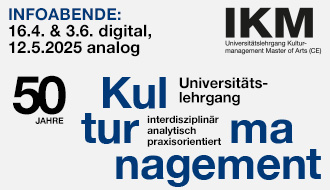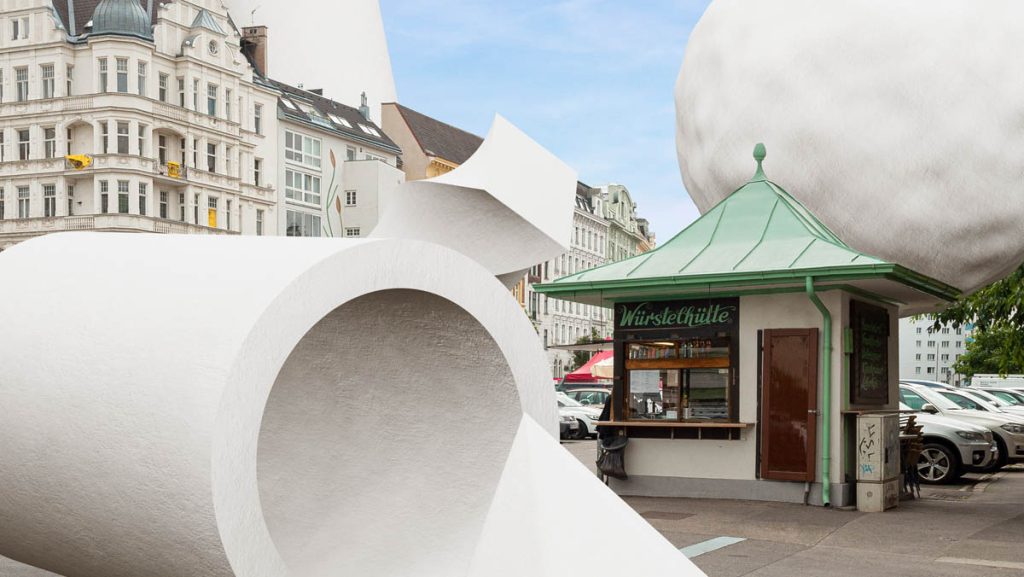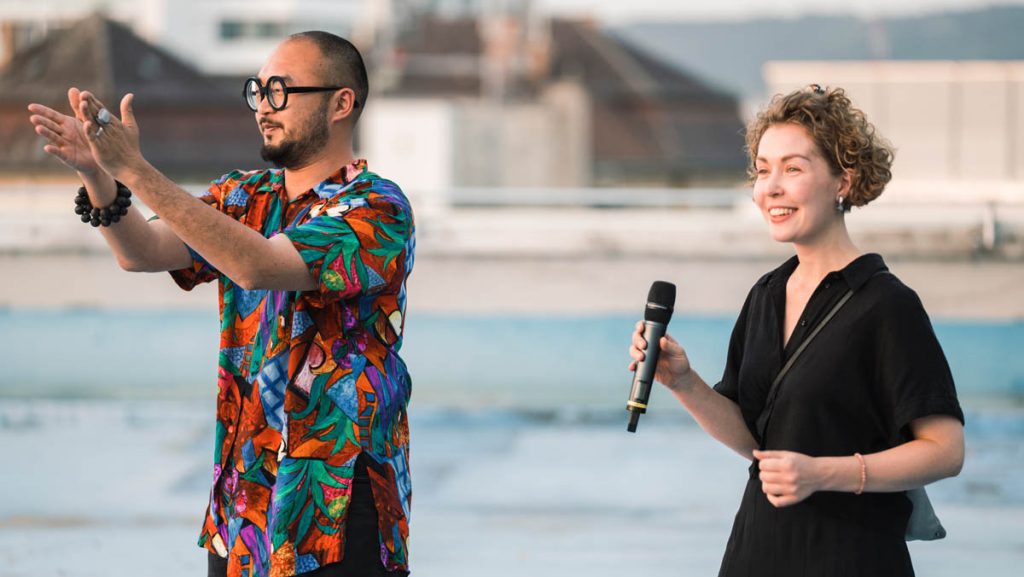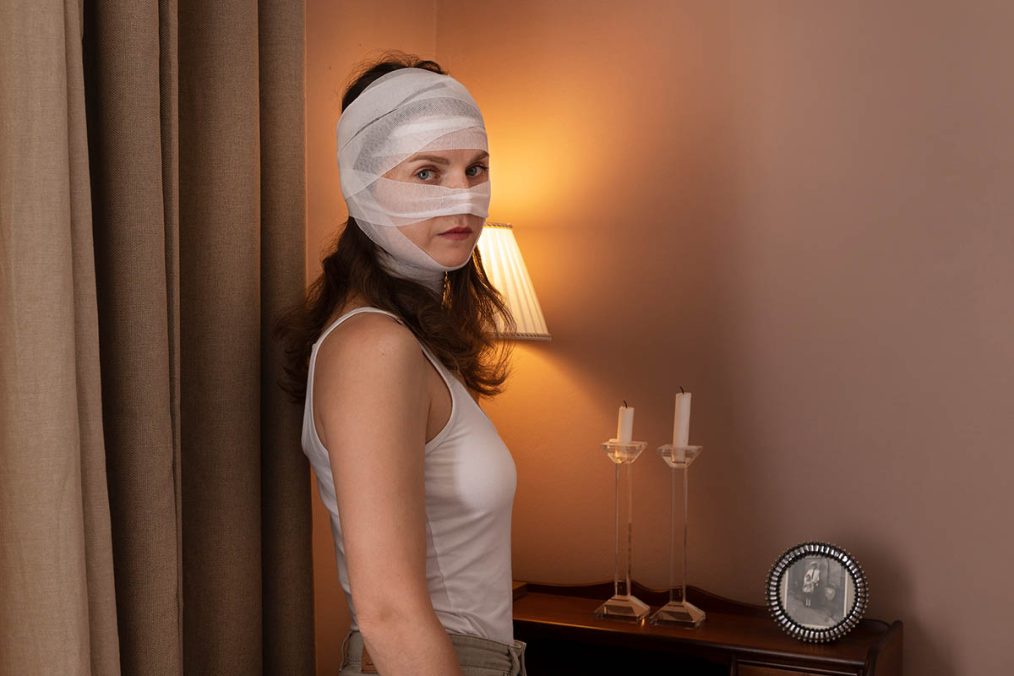
Erka Shalari: How did it start your interest in film and photography?
Caterina Notte: Cinema entered my imagination with the film The Gospel according to St. Matthew by Pasolini when I was 14 years old. From there, the moving image has conditioned my thinking about the work of art as a work that is not necessarily static. Even when I do not work with video, but with photography or installation, I always think in terms of movement and change; every photograph is performative. It has a before and an after and every installation has a condition and a consequence. It is important that there is also a change in the viewer, an event that is part of the sequence of stills I have imagined, which goes from the preparation of the scene to the viewer’s external vision. The transition from analog to digital photography has concentrated this need of mine for movement, and when I photograph today it is as if I were shooting a small film. But my protagonists are not actresses, they are taken from real life and freely decide their own movements within the frame I have designed for them. What interests me is always reality together with its infinite possibilities. While photography allows me to capture every single movement as if it were thought and immobilized at the same time, it is exactly this initial transformation of thought into movement and the transformation of the observed flesh that I try to faithfully reproduce. In movement lies the will, the power to control one’s actions, and the ultimate goal. In short, it is as if I wanted to concentrate on a single still on the conditions of before, during and after. Each resulting image is a process in metamorphosis. What counts for me is the moment dedicated to acting, when you finally regain possession of your body, of your consciousness in a rewritten movement.
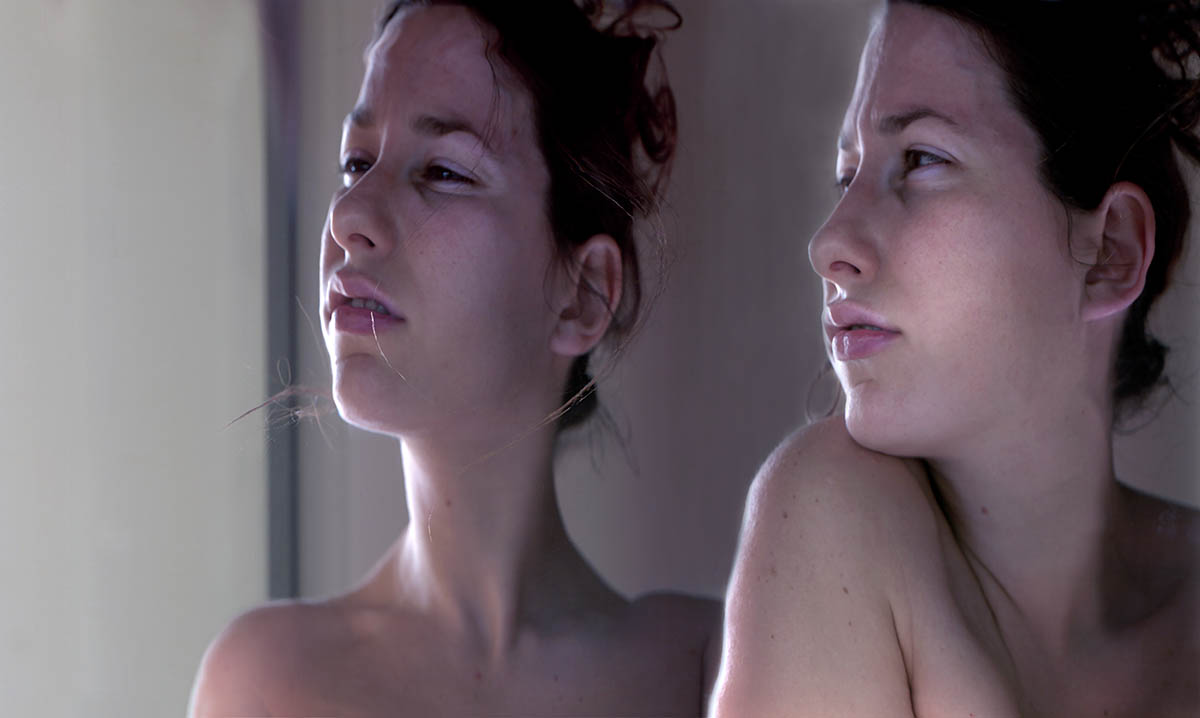
How would you describe your videos, protagonists, and themes?
My videos are very close to the concept of films in terms of narration, editing, and music. There is always music in my videos (…) my protagonists are silent and enveloped by the music. They explore their relationship with their place, their body and their limits, and experience the superiority of the nature that surrounds them. One of my earliest videos Domus de Janas (2003), presented in March in the Les grasses matinées exhibition at Careof and previously at Galeria Bellas Artes in Santiago de Chile, deals with the absolute dependence of the human being on the dimension of reality that bewitched him, captures him and kidnaps him. Recovering one’s relationship with nature, with one’s own biology, is a ground for human growth. It is a natural empowerment and greater cohesion that can help him free himself from the stratification of judgments, stereotypes, and needs. The protagonists of my videos are only aware of the time course of the actions, their beginning and end, but their movement within the video sequences is spontaneous and natural just as it would be in reality. I am not interested in my protagonists playing a part, but in them acting as it would be most natural for them to move in that situation. In the video Autostart-Repeat (2002), the protagonist was given balloons and the precise input that she only had to breathe from the tube stuck in the ground. Everything else happened spontaneously as if a gap had actually opened in her reality where she was forced to hold her breath. This is not a dream image but a possible reality. Reality is movement and uncertainty, but it is precisely in this state of uncertainty that the individual can choose to become strong. As is the case in my latest video Freezdom (2021); my script involved a ‚gauzed‘ little girl measuring her freedom as she separates from the gauze. The dance I observed was her spontaneous expression, which I had not anticipated at all. The human presence is indispensable for me, even when I only work with places, as for example during the first hard lockdown in Munich in March: I photographed every corner of the desolate city, without human beings. The photos were then used for director Tamal Mukherjee’s documentary film, ‚Insight‘ (2020/2021) for CNA. It was a unique feeling, suddenly finding oneself without human contact and perhaps afraid to have it. I then reflected on the defragmentation of the individual they have put in place and the non-neutrality of the society they are creating, and I believe there is now a pressing need to voice an intimate protest that expands, and so the latest series Die Reise eines Mädchens was born.
For a long time you’ve carried out scanning processes of yourself. I have to ask how it felt to fragment one’s own body and then reassemble it?
My first work Genetics is a photographic work born from direct scans of my body that I fragmented on a normal A4 scanner. For a few years, I reassembled the parts of my body thus scanned and digitally reconstructed, to obtain clones of myself that became at least as real as I was. This is the precise moment when I disengaged myself from an initial repetitive cycle and freed myself from self-observation by multiplying my alter egos. The end product of this process was a photograph that retained all the illusion of reality but with a more liquid flavour. The scanner was for several years my first camera in the domestic space, with which I explored my whole body, fragmented it, reconstructed it, cloned and recloned it. How did I feel? Expanded, not constricted, I had found an escape route from reality or rather a way to augment it and I felt exactly like Schrödinger’s cat, with my feet in two dimensions, each of which could suddenly be realised at the expense of the other. It was undoubtedly the beginning of a long journey of introspection that started with me and ended with the women and children protagonists of the Predator series who replaced me in this process of recovery and rewriting of body and flesh.
Let us stay at the series of works ‚Predators‘. I would like to hear more about it.
The Predator series started in 2010 with four 10-year-old girls, a van and some surgical gauze. I have always worked with children and that day I had four of them. I had some wallpaper with me and some rolls of surgical gauze that I always carry with me for emergencies. I don’t know how it happened but I found myself wrapping them to enhance their eyes, those little girls had really big eyes! And at the same time (as always happens in my work) I also wanted to give them the possibility of overcoming a constraint, of acting in some way against my will, and so, like a jigsaw puzzle, I pieced together the idea of fragility that I had in mind and the image of the four swaddled girls driving a blue van in a Balkan-style countryside was born. Initially, I thought I had some control over them, but instead, they completely turned the scene upside down. I felt like an observer who was a victim of their gaze. I realized at that moment that there is a possibility of reversing one’s role by freeing oneself from observation. And from that day on, I continued to work on this series, deepening the theme of control, surveillance, participatory observation, and the rewriting of weakness in power. The gauzes have taken on an increasingly important role, they do not hide or cover wounds but bind, they delimit the space of the eyes, of the mouth. They transform weakness into potency. They heal, they unite, they strengthen. As I delved deeper into this work, I found echoes of the history of my home country, Molise, where women wrapped their calves and feet before going to work in the fields, or where the bodies of newborn babies were wrapped in long white bands to support the spine, or where babies during their first year of life wore a Franciscan cord. I discovered that my story is one of ties and bandages and I tried to give them a new perspective and new meanings. The gauze has an ethical, evangelical value that stems solely from the subject’s willingness to free himself from observation.
What power do book publications have and what are they able to add to your work?
I published the book Predator recently, more or less after 11 years of working with this series. It was born on the occasion of a solo exhibition at the Civico Museo Setificio Monti curated by Ambra Patarini, and includes not only a selection of works from the Predator cycle but also parts of interviews from the last year that clarify some key points of this work. In a book, photographs do not appear exactly as they should, but a book undoubtedly allows a deeper reading of an artist’s research, historicism makes it permanent, and concrete. For me, it is very important to disseminate my work in different channels and with the book I can recover the relationship between image and writing.
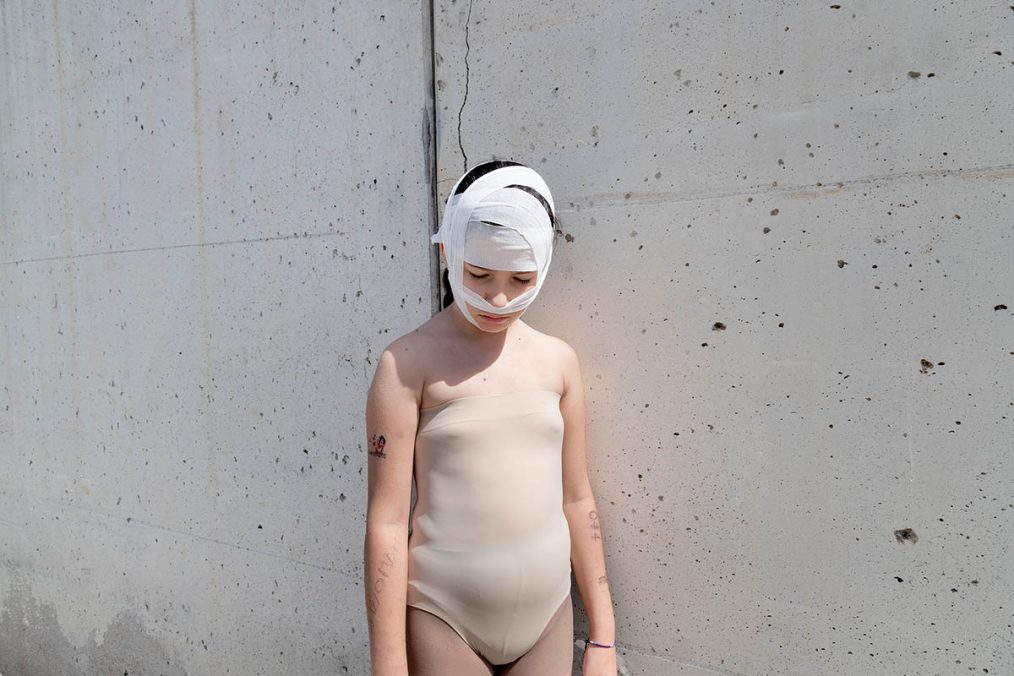
I have the feeling that also in Predators (like in Genetics that we talked about before) you are continuing in fragmenting the human body.
I had not yet thought of this vision but now that you point it out it is true, even in Predator I fragment the bodies thanks to the gauze that as I said delimits physical spaces on the flesh, they dissect it. The bodies are divided but at the same time united, they have faced the separation of the parts but they exhibit the union, the bond. Every part of our world, of our language is intrinsically linked to forming a system. So is our body. Some bonds divide, but others must be recovered and emphasized so that the body-system survives and does not remain neutral, but rational and coherent. Banding the head is like caring for it, protecting it but at the same time giving it solidity and power, annulling hierarchies and differences but at the same time declaiming them, emphasizing each individual eye, each individual nose or mouth.
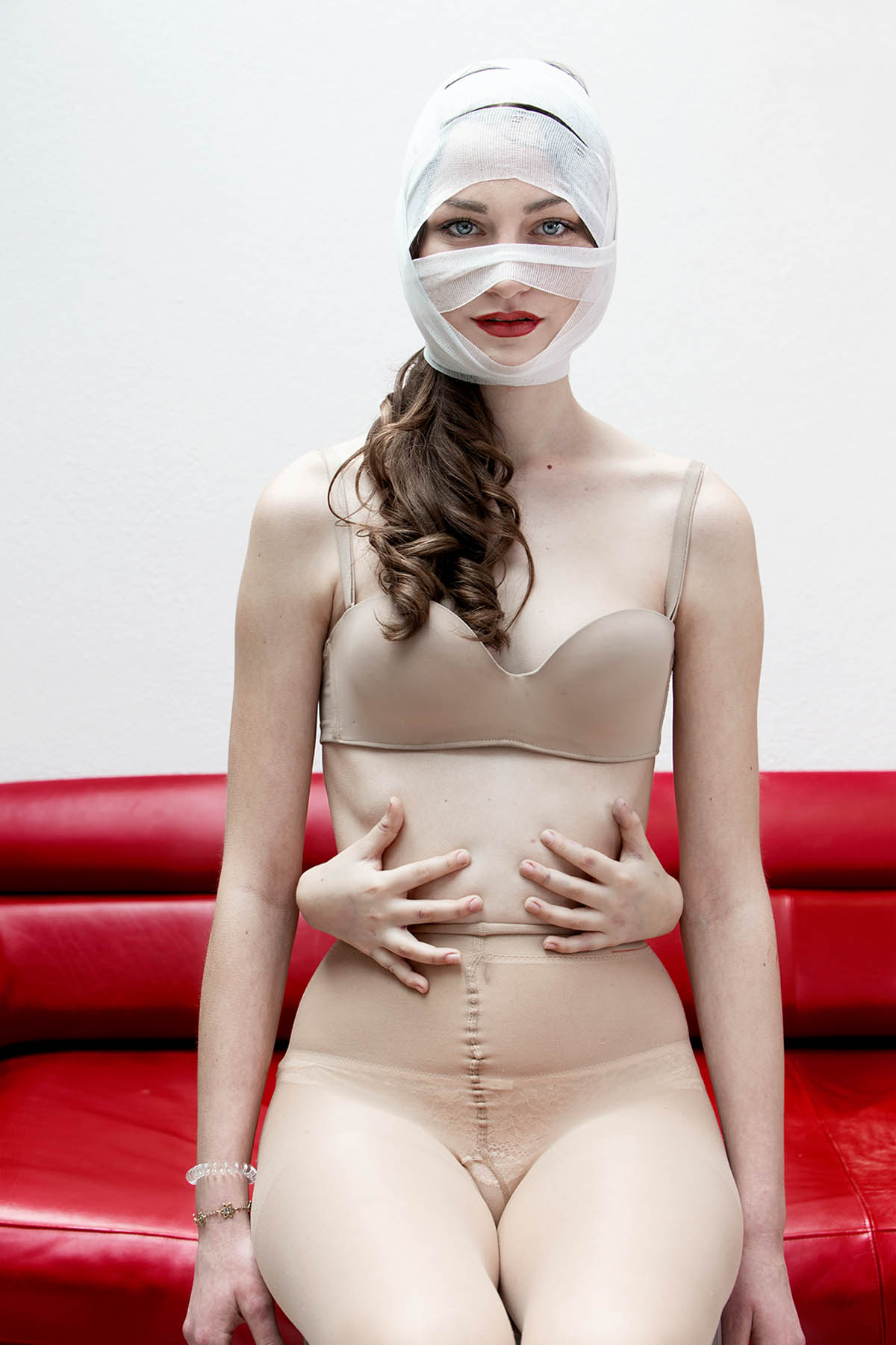
How do you choose the protagonists in your work? Do you work with them merely for a single project or do you sometimes return to your subjects? Which camera do you use?
After the Genetics phase, I shifted my focus to bodies other than my own: children, girls, women. The path has become more difficult: choosing the right subjects is really complicated. Thanks to social media I have a vast territory in which to search, I therefore devote a lot of time to research and casting. I have very clear ideas about the type of subject so the search is still very hard and selective and sometimes does not give immediate results. And add to that the fact that for a job like mine, in which women have to exhibit their primordial nature that does not necessarily enhance their outward femininity, I unfortunately find a lot of resistance. I now have a discrete group of girls, girls and women that is constantly expanding. Before I bring them into my work, I need to talk to them, I very often spend time together, staying with them make them think about certain aspects I care about so that they are ready to launch their message on their own. Once on stage, they are completely free and aware of what they are doing, why the gauze and why the signs, they are always very proactive. Of course, many of them also collaborate on my other projects, it’s a bit like having a „factory“ to rely on.
The camera I use is a Canon full frame which works very well with real colors, not saturated at all, but what I really need is natural light and a tripod. I like to achieve color through light, not through special effects. I don’t like what is artefactual, I aim for reality, which is what I have to present as truthfully as possible. Each shoot takes at least three hours but the selection of images takes much longer, sometimes days, sometimes weeks. I have very precise ideas in my head about what I want, but I don’t give in to the beauty of the shot. This can slow down the process but the image I choose must be true, lacerating, without compromise. I don’t look for illusions but I want to get out there and put out something that wasn’t there before in reality, but is still true.
In PREDATOR UBIQUITY you either find your subjects or they find you on TikTok. What do you think of social media?
Predator Ubiquity was born during the hardest lockdown. I thought that was the best time to measure one’s desire for freedom. So on TikTok I launched the project, anyone could send me a video in which they entered the scene freeing themselves of the gauze with which they had previously wrapped themselves. I received some very interesting videos, but I noticed in general a lot of reticence. On social networks there are rules, customs and manners, they are small worlds that are already structured, I would say automated, and going outside the box, even on TikTok or Instagram where everyone easily shows their body, their face or their loved ones, is not at all usual. The aim of the project I was saying is to measure the degree of freedom perceived by undoing the blindfolds, but there seems to be a lot of fear. This gives me incentive to continue.
How has been received this work?
I made a book out of it, and I have had over 30 interviews with it in the last two years. In general, it is a very broad, conceptually open project that touches on different themes, gender violence, surveillance, weakness, beauty, the body. It is precisely a work on the rewriting of weakness in power. It was presented in a more activist version in 2021 in Shanghai at the German Consulate by Whywhyart in the international project Antonyms, which called for an action in public spaces with posters in the city. I chose the places under surveillance in Costa Smeralda during the lockdown. I was very interested in the alienating effect of the hyper-supervised but at the same time empty place.
In September, the Civico Museo Setificio Monti (Lecco) also presented a solo exhibition of mine dedicated to the Predator cycle curated by Ambra Patarini, the focus this time was on the link with the history experienced by the women in that place, the silk factory. Here I presented Predator#220 of the cycle is dedicated to ecology for the first time. It is a work made with silk threads from the 19th century that the Museum made available to me and eventually printed on a bactericidal fabric with an advanced technology that purifies the environment in which we live.
Both the fabric and the very materials of the place where the work was installed, the wood, the large twisting mill used by women at the time of the silk factory, charged the ethical and ecological message of the work.
I have also been participating with the same project in a cycle of bi-personal exhibitions „Re-genesis“, curated by Sandro Orlandi Stagl and organized by the gallery ARTantide at several museum venues with the presence of an interactive installation of Michelangelo Pistoletto’s Third Paradise.
I’m thinking about the work „Frauen“ (Women). At first sight, the selected photographs give one the feeling of being on the website of a lingerie shop. Can you expand a bit on the narratives of this work for us?
I like that you ask me this question. The women in this small photographic series are captured and observed in their most intimate splendor, safely ensconced in the place where they observe and re-observe themselves, and finally allow themselves to be observed. I have explored here precisely the desire to be seen. A desire certainly stronger in women than in men. A desire that has become a need, disguised as a want and an aspiration. In reality pure dependence on the observer and unconscious and naive acceptance of one’s condition as an observed subject. It is precisely this naive desire that then inevitably leads one to bind oneself to the cycle of continuous observation and re-observation from which one urgently needs to distance oneself in order to be able to ‚act‘ only within one’s own role. It is in this desire that the seed of invisible surveillance is hidden, it is this desire that consciously needs to be rewritten.
The bandages, I can understand, certainly do not fit into the network of ordinary tools used on social media.
How important is it for you to exhibit your works in shows with other artists?
Every external input is a stimulus for me to expand my research in other directions and to find further validation in different experiences; getting involved in collaborative or participatory situations always proves to be an opportunity to become more precise and simple in the exposition of my work. This happened with Fatodol, the performance installation within the IOProject residency, or with La Scala at the Fondazione Ratti. These were operations born out of the presence of a group with whom I lived for days. Participating in a common experience with multiple visions is the minimum condition to be able to interpret my world with my individuality. This is why I always seek a dialectical and continuous relationship with the subjects of my work because it is communication, confrontation that allows one to reveal oneself better. I have always thought that even unexpected and unwanted stimuli have the power to lead to a more conscious and precise rewriting of one’s individuality. I believe that the greatest danger today is that of shirking too easily and naively the duty to recover our very being as individuals in order to participate powerfully in the collective world. It is our ethical responsibility to be able to disengage from any repetitive cycle constructed for us or by ourselves and instead identify ourselves as a free human being.
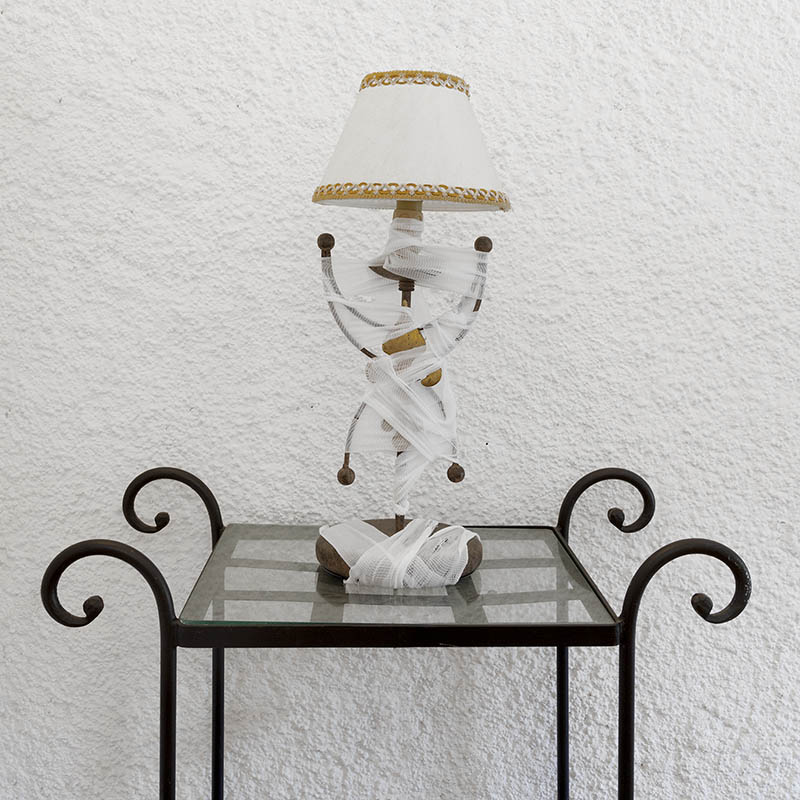
My story is one of ties and bandages 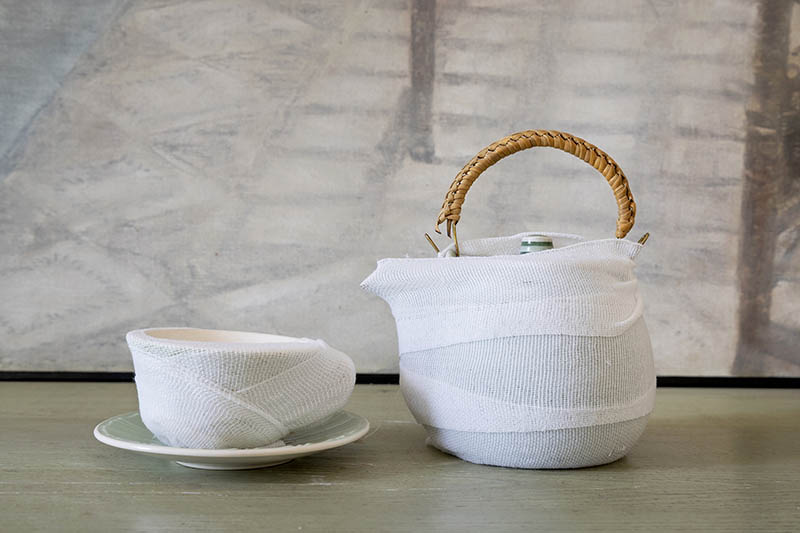
My story is one of ties and bandages
What are you working on at the moment?
I am working on the series Die Reise eines Mädchens, again linked to the Predator cycle, this time it is the protest signs that the little protagonist of the journey to Munich writes and displays in the places where she finds herself. The desire to be seen has turned into a desire to be visible and to make one’s intimate protest visible among people and places. A 10-year-old girl did it, we could do it too. I am in the process of finalising a new book to be published by the publisher Le piccole pagine, I’ve collected a series of contributions from researchers, philosophers and curators but also small interviews with the women in my projects.
It is a challenging but necessary project that brings new confirmations to my research, every research even if only visual needs scientific observations that the artist cannot give but can seek. Then, I am also working on a new exhibition to be held in September. “Cercando la libertà – Storie di diritti negati, dallʼAfghanistan allʼEuropa” an exhibition at Binario49, curated by Benedetta Incerti, here I will work with sound, which is another important element of my work. The sound that permeates everything and penetrates even where the body does not enter. I have just completed an installation and sound project “Nein, Kein, Nie” made of gauze, sound and photography, an immersive protest for the even more resilient viewer. All of this leads to my latest series of works that I am working on assiduously at the moment, Predator action object#, which is dedicated to objects that women have used and use.
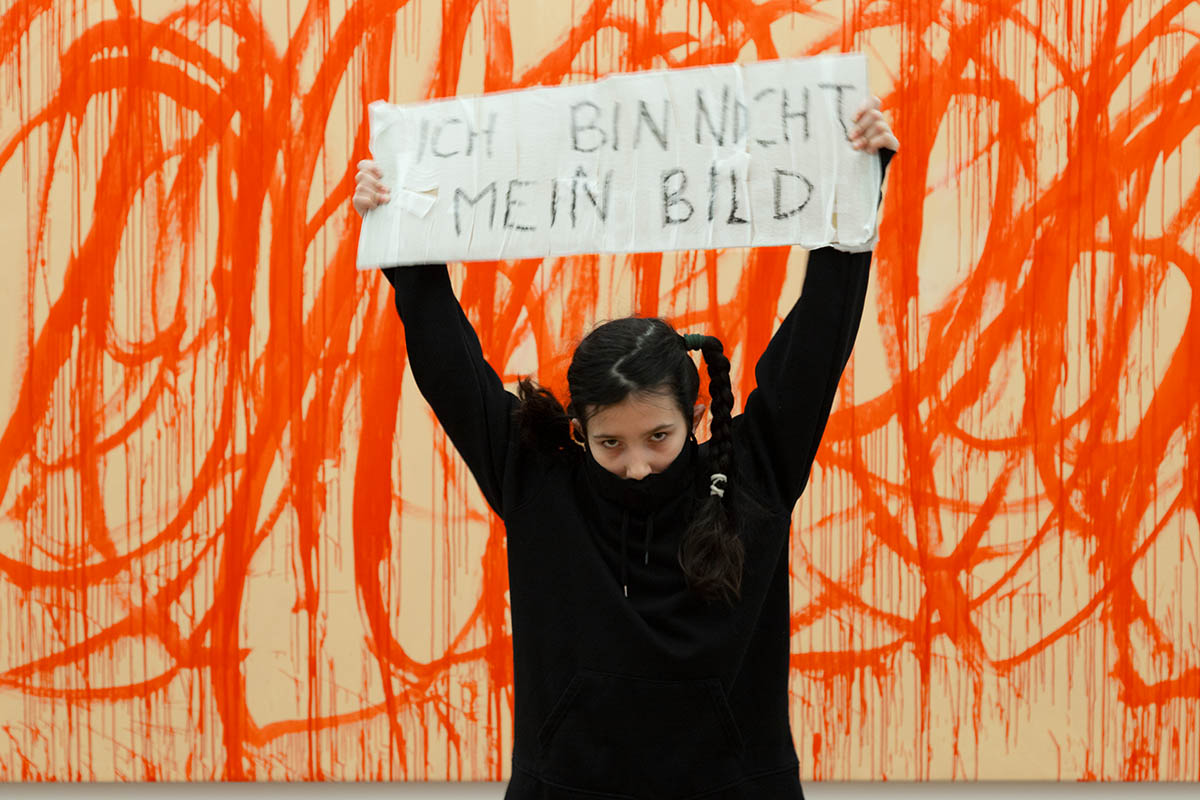
They are teapots, books, hearth utensils, paintings, candelabra, clothes that I bundle with the same gauze that gets dirty, ruins until it becomes unusable at the end of the day. It is a very physical and temporal work, focusing on duration and memory that invalidates our true knowledge of the physical world.
Furthermore, all objects, with which we interact, contain and preserve a tension over time, our tension towards them. They become familiar because we recognize in them each time the same purpose and role we have given them, and again there is a movement towards them. So even objects contribute to limiting repetitive cycles, so much so that we eventually attribute our images to them a priori. And so I gauze them to avoid the pre-constituted image of them that we have automatically made for ourselves in using them. I also find it ethical to give objects back the image they have, regardless of our observation of them. In short, it is again a matter of links and movements becoming evident.
Caterina Notte (1973) lives and works in Munich and Sardinia.
Cerina Notte – www.caterinanotte.com
Note: During the final editing of this conversation, I listened to „Gospel according to St Matthew“. The movie’s sound as a background for completing this piece brought me closer to Caterina Notte’s work. Erka Shalari, 26th of June, 2022



